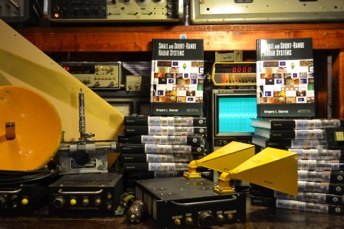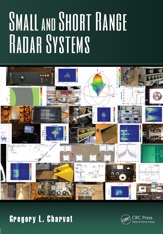
Small and Short Range Radar Systems
G. L. Charvat, “Try Radar for your Next Project,” Guest Post, Hackaday, February 24, 2014.
Review
"This book is absolutely unique in its focus on hands-on construction and demonstration of a variety of small, low-power, short-range radar systems. It is supported by extensive online support resources: measured data sets, MATLAB® analysis software, additional documentation, and demonstration videos. With the aid of this book, anyone with basic electronic circuit skills can construct and operate their own small radar systems and demonstrate essential radar techniques, from such basic operations as moving target detection and speed measurement to sophisticated imaging methods. …It is no exaggeration to say that no other book compares with this one. There are many books on radar systems generally and radar signal processing specifically, and also a few books or chapters in edited books that specifically address FMCW radar, but none has the emphasis on practical radar construction with detailed circuit design and experimental data seen in this text. …Short-range radars are increasingly ubiquitous, not only in the traditional police, motion sensing, and proximity applications, but increasingly in automotive safety, through-wall imaging, and others. This book is a comprehensive guide to the technology of this increasingly important area."
—Dr. Mark A. Richards, Georgia Institute of Technology, Atlanta, USA
"The book is applications-oriented with just enough information, delivered at just the right points, to give the reader a straightforward, clear understanding and appreciation of radar for practical applications. I can think of no other texts that specifically apply conventional radar theory to general short-range problems. As inexpensive imaging and short-range radars are becoming increasing prevalent, it is important that good texts be available to teach engineers about the right way to go about building radars and optimizing their performance. …The selection and presentation of topics is perfect for the modern radar engineer. Proceeding from a general description of radar theory to specific radar systems to particular applications is logical and intuitive. Nothing within the scope of the book is left out: it is very complete. …This book is a great reference, one that should be on every radar designer’s bookshelf. It is segmented enough with self-contained sections to make it easy to find solutions to specific engineering problems down the road. I particularly like the parallel structure of the various radar implementations. Giving the expected performance of each radar system, for example, guides the reader in his/her selection of a particular configuration for a given application. …The references are numerous and complete, and the author is well-known as an active contributor in the radar field. In addition, the text provides sufficient theory to justify each next step. …Unlike conventional radar texts, Charvat’s book gives the reader the knowledge and understanding to develop and use radars for practical, everyday applications. The presentation reminds me of a car-repair manual, with careful step-by-step instructions and well-illustrated with highlighted photographs and circuit diagrams, but with just enough math to justify the various approaches used."
—Prof. Carey Rappaport, Northeastern University, Boston, Massachusetts, USA
"This textbook fills a large void by providing real world examples of Doppler, ranging, and synthetic aperture radar systems along with extensive examples of radar sensitivity and design parameters. Its coverage of fundamental radar principles in a form directly accessible to students is unique, and provides a needed hands-on based approach to the subject. It enables radar investigations using systems that can be readily built at reasonable cost, straightforward computer analysis code, and well verified test data. Students can use these features to learn radar by example in a manner previously very difficult to accomplish. …The material fills a niche not currently found in the literature: real-world examples of small radar systems that can be implemented by students and professionals new to the field. There is a large need for such material in the university and educational community, as most radar courses feature large and complex system designs costing significant amounts of money. This fact tends to produce a large disconnect in student minds between the theory they are learning and actual practice in how to implement this theory. In other words, the student assumes that it must take a team of people and a lot of resources to successfully implement and deploy radar systems. However, the principles of radar work equally well on small systems. The ability to have students assemble, test, and process data from these systems is really invaluable. I have seen this type of hands-on learning provide insights and synthesis of material much quicker than traditional methods of learning important radar principles. Having a textbook with validated examples of small radar systems, and with simple computer code and test data sets to check knowledge of theoretical constructs, provides the needed bridge to this type of learning. …The material is most definitely interesting, primarily by virtue of worked-out calculations giving real-world answers to common radar design problems (and then showing processed data examples). There are practically no sources of publicly available test data for SAR algorithms or for FMCW ranging radars. These worked-out examples are therefore unique and badly needed. …I am impressed with the breadth of topics covered. For the target audience, this material seems ideally suited and I do not find any significant missing topics. After assimilating this material and working through the exercises, students will be much more ready to tackle the classic radar textbooks (Skolnik, etc.) and will have a much more intuitive feel for core principles."
—Dr. Philip Erickson, Principal Research Scientist, MIT Haystack Observatory, Westford, Massachusetts, USA
"I wish I had a book like this when I was developing short-range radars. The author provides a variety of practical circuits and block diagrams that practicing engineers and students will find useful. …The best feature of this book is the wealth of practical information in the form of block diagrams, circuit diagrams, and measurement results that help the reader understand how to turn the theory of small radars into practice. I like the author’s approach of providing just enough theory to help the reader understand the operation of short-range radars and to interpret the measurement results. …I’m not aware of any other book directed solely toward small and short-range radars. I believe this book is complementary to comprehensive treatments such as Principles of Modern Radar by Richards, Scheer, and Holm and Skolnik’s Radar Handbook."
––Prof. Daniel Fleisch, Ph.D, Wittenberg University, Springfield, Ohio, USA
"This book presents a nice introduction to short-range radar systems with both theoretical and practical insights. I would recommend it to anyone interested in not only understanding but also building short-range radar systems. …The book covers all essential aspects of short-range low-power radar systems. A major strength of the book lies in the combination of both theoretical and practical insights. The examples provided in the book are particularly helpful in not only understanding but also in building actual systems."
—Prof. Xiaoguang ‘Leo’ Liu, Ph.D, University of California, Davis, USA




